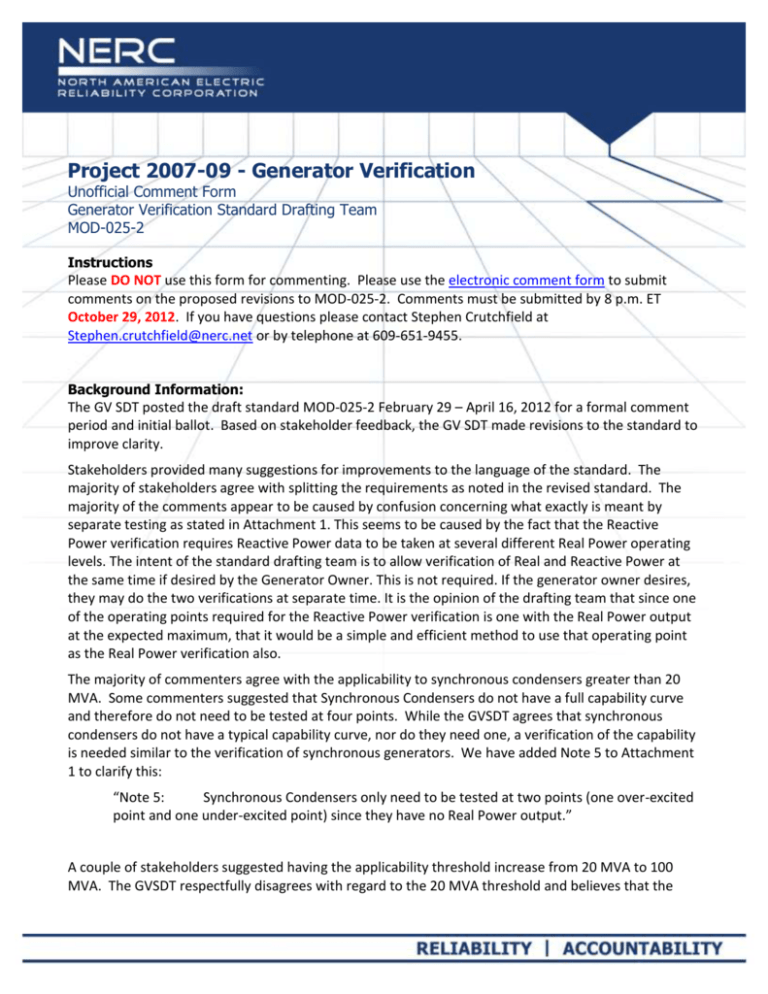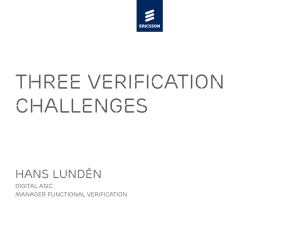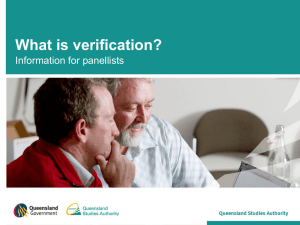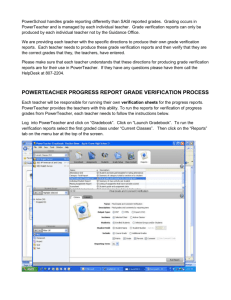Project 2007-09 - Generator Verification
advertisement

Project 2007-09 - Generator Verification Unofficial Comment Form Generator Verification Standard Drafting Team MOD-025-2 Instructions Please DO NOT use this form for commenting. Please use the electronic comment form to submit comments on the proposed revisions to MOD-025-2. Comments must be submitted by 8 p.m. ET October 29, 2012. If you have questions please contact Stephen Crutchfield at Stephen.crutchfield@nerc.net or by telephone at 609-651-9455. Background Information: The GV SDT posted the draft standard MOD-025-2 February 29 – April 16, 2012 for a formal comment period and initial ballot. Based on stakeholder feedback, the GV SDT made revisions to the standard to improve clarity. Stakeholders provided many suggestions for improvements to the language of the standard. The majority of stakeholders agree with splitting the requirements as noted in the revised standard. The majority of the comments appear to be caused by confusion concerning what exactly is meant by separate testing as stated in Attachment 1. This seems to be caused by the fact that the Reactive Power verification requires Reactive Power data to be taken at several different Real Power operating levels. The intent of the standard drafting team is to allow verification of Real and Reactive Power at the same time if desired by the Generator Owner. This is not required. If the generator owner desires, they may do the two verifications at separate time. It is the opinion of the drafting team that since one of the operating points required for the Reactive Power verification is one with the Real Power output at the expected maximum, that it would be a simple and efficient method to use that operating point as the Real Power verification also. The majority of commenters agree with the applicability to synchronous condensers greater than 20 MVA. Some commenters suggested that Synchronous Condensers do not have a full capability curve and therefore do not need to be tested at four points. While the GVSDT agrees that synchronous condensers do not have a typical capability curve, nor do they need one, a verification of the capability is needed similar to the verification of synchronous generators. We have added Note 5 to Attachment 1 to clarify this: “Note 5: Synchronous Condensers only need to be tested at two points (one over-excited point and one under-excited point) since they have no Real Power output.” A couple of stakeholders suggested having the applicability threshold increase from 20 MVA to 100 MVA. The GVSDT respectfully disagrees with regard to the 20 MVA threshold and believes that the same MVA threshold used for reactive capability of synchronous generators should apply to synchronous condensers. Most stakeholders agree with having the verification data submitted to the Transmission Planner. A few commenters suggested that the information should be provided to other reliability entities such as the Reliability Coordinator, Balancing Authority or Planning Authority (Coordinator). As this is a longterm planning standard, it is envisioned that the TP receives the data and develops the appropriate models for use by other entities. The TP then hands these models off to entities that are concerned with the Operations planning and Real-time Operations time horizons. Per the NERC Reliability Functional Model (v5, page 25), the Transmission Planner has the following relationships with other entities: 2. Collects information including: c. Generator unit performance characteristics and capabilities from Generator Owners. 5. Coordinates the evaluation of Bulk Electric System expansion plans with Transmission Service Providers, Transmission Owners, Reliability Coordinators, Resource Planners, and other Transmission Planners. 6. Reports on and coordinates its Bulk Electric System expansion plan implementation with affected Planning Coordinators, Transmission Planners, Resource Planners, Transmission Service Providers, Transmission Owners, Transmission Operators and Reliability Assurers. The GVSDT has not revised the requirement with which continues to require the data be submitted to the Transmission Planner. Several stakeholders disagree with the use of “bulk power system” in the applicability. The GVSDT has revised this to use the term “Bulk Electric System” instead. Concerns were raised regarding the verification schedule for entities that own five or fewer units. The GVSDT removed Sections 5.1.1 and 5.2.1. Entities that own one unit will be required to verify their unit within two years. Entities that own two units will be required to verify one unit within two years and both units within three years. The GVSDT received several comments regarding the language in Attachment 1. As a result the GVSDT restructured item 2 of Attachment 1: 2. Verify with all auxiliary equipment needed for expected normal operation in service for both the Real Power and Reactive Power capability verification. Perform verification with the automatic voltage regulator in service for the Reactive Power capability verification (see Note 3 if the automatic voltage regulator is not available). Operational data from within the two years prior to the verification date is acceptable for the verification of either the Real Power or the Reactive Power capability, as long as that operational data meets the criteria in 2.1 through 2.5 below. A Reactive capability test must demonstrate at least 90 percent of a previously staged test that demonstrated at least 50 percent of the Reactive capability shown on the associated thermal capability curve (D-curve). If the previously staged test was unduly restricted by Project 2007-09 Generator Verification Comment Form – October 4, 2012 2 unusual generation or equipment limitations (e.g., capacitor or reactor banks out of service), then the next verification shall be by another staged test, not operational data: 2.1. Verify Real Power capability and Reactive Power capability over-excited (lagging) of all applicable Facilities at the applicable Facilities’ normal (not emergency) expected maximum Real Power output at the time of the verifications. 2.1.1 Verify synchronous generating unit’s maximum real power and lagging reactive power for a minimum of one hour. 2.1.2 Verify variable generating units, such as wind, solar, and run of river hydro, at the maximum Real Power output the variable resource can provide at the time of the verification. Perform verification of Reactive Power capability of wind turbines and photovoltaic inverters with at least 90 percent of the wind turbines or photovoltaic inverters at a site on-line. If verification of wind turbines or photovoltaic inverter Facility cannot be accomplished meeting the 90 percent threshold, document the reasons the threshold was not met and test to the full capability at the time of the test. Reschedule the test of the facility within six months of being able to reach the 90 percent threshold. Maintain, as steady as practical, Real and Reactive Power output during verifications. 2.2. Verify Reactive Power capability of all applicable Facilities, other than wind and photovoltaic, for maximum overexcited (lagging) and under-excited (leading) reactive capability for the following conditions: 2.2.1 At the minimum Real Power output at which they are normally expected to operate collect maximum leading and lagging reactive values as soon as a limit is reached. 2.2.2 At maximum Real Power output collect maximum leading reactive values as soon as a limit is reached. 2.2.3 Nuclear Units are not required to perform Reactive Power verification at minimum Real Power output. 2.3. For hydrogen-cooled generators, perform the verification at normal operating hydrogen pressure. 2.4. Calculate the Generator Step-Up (GSU) transformer losses if the verification measurements are taken from the high side of the GSU transformer. GSU transformer real and reactive losses may be estimated, based on the GSU impedance, if necessary. Some commenters had questions regarding Section 5.3 regarding wind farms. The GVSDT acknowledges that this statement was placed in the standard as an explanation and is not appropriate Project 2007-09 Generator Verification Comment Form – October 4, 2012 3 to be included as section 5.3. This information was expanded and included as a footnote rather than section 5.3: 1 Wind Farm Verification - If an entity has two wind sites, and verification of one site is complete, the entity is 50% complete regardless of the number of turbines at each site. A wind site is a group of wind turbines connected at a common point of interconnection or utilizing a common aggregate control system. Questions: You do not have to answer all questions. Enter All Comments in Simple Text Format. Insert a “check” mark in the appropriate boxes by double-clicking the gray areas. 1. The GVSDT has revised attachment 1 based on stakeholder comments. Do you agree with this revision? If not, please explain in the comment area below. Yes No Comments: 2. The GVSDT has revised the VSLs based on stakeholder comments. Do you agree with these revisions? If not, please explain in the comment area below. Yes No Comments: 3. Do you have any other comment, not expressed in questions above, for the GVSDT? Comments: Project 2007-09 Generator Verification Comment Form – October 4, 2012 4







